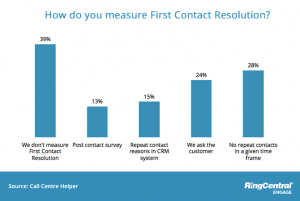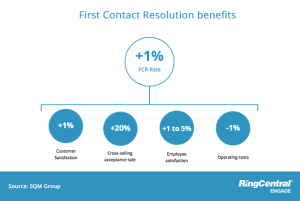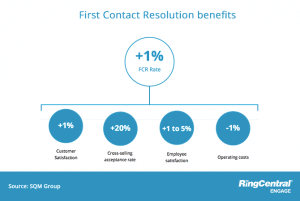Monitoring the right KPIs is paramount to steering the business of your customer service department. Among the key indicators, we regularly hear about NPS (Net Promoter Score) or average handling time. However, other strategically important KPIs may be considered. One of these indicators is the First Contact Resolution rate, which presents many important advantages for customers and the company.
What is First Contact Resolution rate?
Definition
First Contact Resolution rate (FCR) measures the proportion of support requests solved upon first contact, thereby eliminating the need for the customer to make contact again.
This indicator was originally used for phone calls, under the name “First Call Resolution Rate“. It has since been adapted to the digital world with the term “first contact”. In an omni-digital context where there are many channels for contacting a company (messaging, email, chat, social networks etc.), it can be more difficult to find out if the customer has contacted the company via another channel.
The First Contact Resolution rate can vary vastly between industries and different customer service teams. For example, we can imagine that level 1 requests can be more easily solved upon first contact than technical requests. Variations can also be observed depending on the manner in which each company measures this indicator.
According to current benchmarks, the global average First Contact Resolution rate is around 70%.
How can we measure it?
The First Contact Resolution rate is calculated by dividing the Number of requests solved upon first contact by the Total number of requests.
Cyril Fontaine, customer care expert with more than 20 years’ experience, explains the challenges linked to measuring this indicator:
| “There is not a single “First Contact Resolution rate” but many, which makes benchmarks complicated between industries and even between companies in the same industry. The measurement times of this KPI are very variable according to the Companies (after 48 hours, after 7 days, after 15 days, after 30 days etc.). Duration has a strong influence on the result. What is needed to choose the right analysis time of the “Once and Done” is to establish how long we have the vast majority of redundancies. If you have 95% of reiteration at maximum after 7 days, it makes sense to calculate this KPI over 7 days and improve it over the same period. “ | |

|
Cyril Fontaine Customer Care Expert |
This requires first defining what can be considered a first contact resolution. The most reliable method is to draw upon the customer’s perception to make sure his/her problem has been solved. This allows us to avoid the interpretation of the advisor or the company which could lead to errors. Using a question such as “Did I respond correctly to the subject of your request?” at the end of the interaction allows us to use reliable date to calculate the FCR.
Another approach is based on the fact of whether the customer has contacted the customer service department again during a given period. For example, we can consider that if a customer has not contacted the company again within 10 days, his or her problem has been solved. According to a study, this is the most used method for measuring FCR rates.

This first point addresses the concept of resolution, but evaluating the concept of first contact can be another challenge. On digital channels, it is common for a customer to contact a company by e-mail, then on Twitter for the same problem. If the problem is solved as a result of the interactions on Twitter, this corresponds to several contacts. However, without a global vision of the customer’s digital identities, a company can consider that it is a first contact resolution. Thanks to an omni-digital strategy and identities merging, a company can see that the customer has contacted it twice.
Cyril Fontaine highlights this necessity of a multichannel approach:
| “The Once and Done rate must also be measured across various channels (traditional channels and the customer service sections of websites). It is illusory to think that digital channels (Live Chat/Instant Messaging/Messenger/Twitter/Facebook etc.) by nature generate reiteration. We must instead look at complicated processes, organisations with multiple levels of expertise, the lack of use of tools at the service of advisers such as decision trees to drive processes, the lack of autonomy given to the Advisers/Sales Team etc.) “ | |

|
Cyril Fontaine Customer Care Expert |
Why it is an essential KPI
According to Harvard Business Review, the reduction of customer effort is the most important factor in loyalty. From the customer’s point of view, having his or her problem solved on first contact means there is less effort to make. Contacting the company several times means more time spent explaining the problem in order to solve it. The link between first contact resolution and satisfaction has been demonstrated: according to SQM Group, an improvement of 1% in the FCR rate leads to an improvement of 1% in customer satisfaction. Also, according to a study by Accenture, 80% of customers who have changed supplier due to unsatisfactory service would not have done so if their problem had been solved upon first contact. This ranks the lack of FCRs as the first factor of frustration over the past 5 years.
First Contact Resolution thus represents a reduction in company costs. The reduction in the number of contacts made to solve a problem will automatically lower their costs. SQM Group has demonstrated that a 1% improvement in FCR rate leads to a 1% reduction in operating costs. This is particularly interesting for a company calling upon an external service provider invoicing at cost per action.


One of the other major benefits for customer service is to enable agents to save time: this available time can then be used to deal with more added-value requests and more strategic sales activities. Regarding this last point, first contact resolution has direct consequences on sales opportunities. SQM Group has shown that the acceptance rate of a cross sell increases by 20% when a problem is solved upon first contact.
Cyril Fontaine explains us the reasons for which FCR is an essential KPI:
| “The one-time processing rate is not considered fair value by the companies, as revealed by the KPI benchmarks for customer services: “… 45% of respondents have no objective in this area, do not measure this indicator or do not feel concerned.” It’s 8 points up on the previous year.
This KPI is nevertheless crucial the following are also KPIs:
|
|

|
Cyril Fontaine Customer Care Expert |
How to improve it?
Using routing to transfer enquiries to the right person
Routing allows you to organise incoming message flows and to ensure that they are dealt with by the appropriate agents. Routing can be customised based on your internal processes, using the channel (chat, social networks, email, etc.), the content (keywords), the number of followers, etc. For example, if your customer service is organised by areas of expertise (technical support, invoice-related claims, etc.), you can use routing so that your agents receive the enquiries matching their skills.
Using routing ensures the request reaches the appropriate person, thus contributing to solving requests when contact is first made.
Analyse the reasons for repeated customer requests
Understanding the reasons for which your customers have to contact you several times regarding the same request will help you improve your customer service. By analysing the reasons behind this reiteration, you will then be able to adjust your processes with the aim of improving your FCR rate. For example, if you notice that a specific problem gives rise to a second contact made before it is solved, you can train your agents so that they may better accompany the customer about this type of request.
On the same principle, this analysis may help you to identify the essential information to ask the customer during the first contact made. For example, it will be more effective to ask the customer for all his or her contact details (last name, first name, address, customer ID, etc.) rather than having to contact him again for more information.
Assessing agents on FCR in addition to AHT
Average Handling Time (AHT) is an indicator often used in customer service centres. It measures the time spent by an agent to handle a request. The AHT and the FCR are connected: their ratio will in fact determine the cost for resolving the problem. Let’s take an example with an AHT of 10 minutes: with an FCR of 50%, solving a customer’s problem costs 20 minutes, but only 11 minutes with a 90% FCR.
The assessment according to the AHT may sometimes makes agents want to deal with a request as quickly as possible, without ensuring that the customer’s problem has indeed been solved. Prioritising the FCR rate may change the agents’ approach. They will be more concerned with solving the problem and will have less reason to want to finish the interaction as quickly as possible. Overall, it is more effective from the customer’s point of view and less costly for the company to sort out the problem upon one longer contact than by several short interactions.
On this point, it is essential to take the time to explain to agents the principle of the FCR rate and its positive effects for the company. By understanding its benefits and the influence that their work can have at different levels, the agents will feel more involved in achieving this goal. The FCR not only has a positive effect on customer satisfaction but also on that of the employees (Esat). The study by the SQM Group has demonstrated that a 1% improvement in the FCR rate leads to a 1 to 5% increase in Esat. In fact, the agents are less stressed and more satisfied when they solve a problem on first contact, rather than receiving recurring requests from dissatisfied customers.
Ensure the customer’s problem has been resolved at the end of the interaction
As previously mentioned, it is more reliable to draw upon the customer’s perception to make sure his/her problem has been solved. This can be implemented fairly simply by training the agents. If they become accustomed to questions such as “Have I fully responded to your request?” at the end of each interaction will allow the agent to assess it.
In this way, the customer will have the opportunity to ask more questions if needed rather than renewing a contact, and will be left with a good impression.
Give advisers access to information: training, knowledge base, CRM/DCIP integration…
Providing agents with autonomy will always be beneficial for the company and their effectiveness to deal with requests. Training agents and giving them access to a maximum amount of information will help them solve customers’ issues upon first contact. Training on the company’s products and services is obviously essential.
A knowledge base will also be beneficial: the agent will more easily have access to all the information he or she needs to solve the customers’ problems.
Finally the 360° customer view, made possible thanks to the CRM/DCIP integration will allow the agent to have the maximum amount of information on the customer. During the conversation, he can access the conversation data (digital identities, conversation history etc.) and the transactional data (purchase history, customer status, etc.) to deal with the requests.
The First Contact Resolution rate presents many important advantages for customers and the company. Given its impact on satisfaction and loyalty, it is essential to place this goal at the heart of customer service. A request analysis and agent training process will then identify ways to improve it, to provide an optimal customer experience.
Finally, Cyril Fontaine recalls the importance of innovation on fundamentals of the customer relationship to improve your FCR rate:
| The word INNOVATION is often used for everything and nothing. Shouldn’t Companies innovate on the basics of the Customer Experience by working on the real causes of these reiterations, which are obstacles in terms of Customer Satisfaction and Business? “ | |

|
Cyril Fontaine Customer Care Expert |
Originally published Feb 07, 2018, updated Aug 11, 2020





